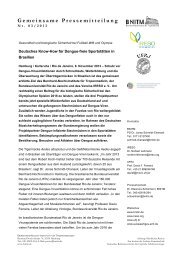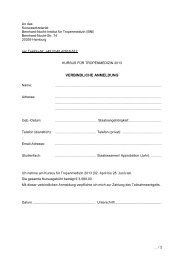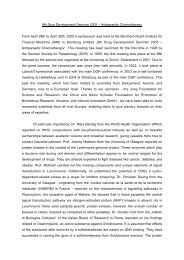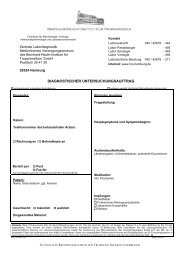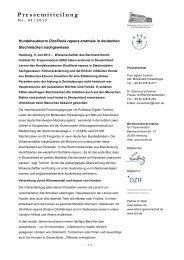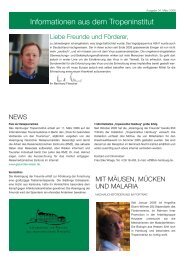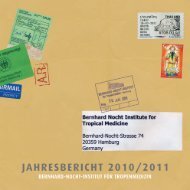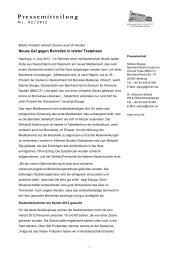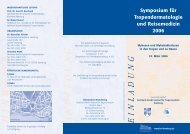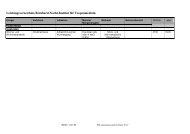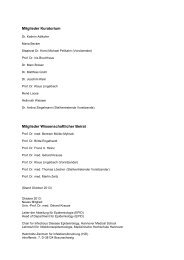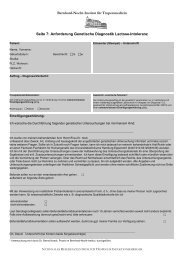Research Group Heussler (Malaria I) - Bernhard-Nocht-Institut für ...
Research Group Heussler (Malaria I) - Bernhard-Nocht-Institut für ...
Research Group Heussler (Malaria I) - Bernhard-Nocht-Institut für ...
You also want an ePaper? Increase the reach of your titles
YUMPU automatically turns print PDFs into web optimized ePapers that Google loves.
Tropical Medicine Section<br />
Genome-wide linkage analysis identifies<br />
polymorphism in the human interferon-γ receptor<br />
affecting Helicobacter pylori infection<br />
Zusammenfassung<br />
Helicobacter pylori gilt als der weitest verbreitete<br />
Infektionserreger des Menschen. Er verursacht<br />
Magenschleimhautentzündungen, Magen- und<br />
Duodenal-Geschwüre und erhöht das Risiko zur<br />
Entwicklung von Magenkrebs. Wir haben senegalesische<br />
Geschwister durch Bestimmung spezifischer<br />
IgG-Antikörper hinsichtlich ihrer Empfänglichkeit <strong>für</strong><br />
H. pylori-Infektionen untersucht. In einer Kopplungsanalyse<br />
mit 400 genomweiten Markern ergab sich<br />
ein LOD-Score von zunächst 2,4 im Bereich des<br />
Gens <strong>für</strong> den Interferon-γ-Rezeptor (IFNGR1), der bei<br />
Ergänzung durch einen Marker innerhalb IFNGR1-<br />
Gens auf 3,1 stieg. Durch Sequenzierung des Gens<br />
bei 20 Geschwistern mit extremen Antikörper-<br />
Spiegeln wurden –56C>T, H318P und L450P als<br />
genetische Varianten nachgewiesen, die in der<br />
Studiengruppe signifikant mit hohen Antikörperkonzentrationen<br />
assoziiert gefunden wurden.<br />
Darüber hinaus hob der Einschluss dieser Varianten<br />
als genetische Marker den LOD-Score der Kopplungsanalyse<br />
auf 4,2. Die Varianten fanden sich bei<br />
Afrikanern häufiger als bei Europäern. Die Ergebnisse<br />
zeigen, dass die IFN-γ-Signalübertragung eine<br />
wesentliche Rolle bei der menschlichen Abwehr<br />
gegen H.-pylori-Infektionen spielt, und helfen die<br />
Beobachtung einer hohen Prävalenz und relativ<br />
niedrigen Pathogenität von H. pylori in Afrika zu<br />
erklären. Darüber hinaus bestätigt die Studie den<br />
prinzipiellen Wert von Kopplungsanalysen bei der<br />
genetischen Untersuchung von Infektionskrankheiten<br />
und anderen komplexen Erkrankungen.<br />
78<br />
Summary<br />
Helicobacter pylori is considered the most common infectious<br />
agent of humans worldwide. It causes gastric<br />
inflammation, gastroduodenal ulcers, and a risk for<br />
gastric cancer. We performed a genome-wide linkage<br />
analysis among Senegalese siblings phenotyped for<br />
H. pylori reactive serum IgG. A multipoint LOD score of<br />
3.1 was obtained at IFNGR1, the gene encoding chain<br />
1 of the interferon-(IFN-)γ receptor. Sequencing of<br />
IFNGR1 revealed ñ56C->T, H318P, and L450P variants<br />
which were found associated with high antibody<br />
concentrations. Including these in the linkage analysis<br />
raised the LOD score to 4.2. The variants were in<br />
Africans more prevalent than in Caucasians. Our<br />
findings indicate that IFN-γ signalling plays an essential<br />
role in human H. pylori infection and contribute to<br />
explain the observations of high prevalences and relatively<br />
low pathogenicity of H. pylori in Africa. Moreover,<br />
they provide further proof of principle for the value of<br />
genome-wide linkage studies in the analysis of susceptibility<br />
to infection and other complex genetic traits.<br />
Introduction<br />
In Europe and the USA, 25-50% of the population are<br />
infected with H. pylori, and prevalences in developing<br />
countries reach 70-90% with almost all acquiring the<br />
infection before the age of 10 years. Approximately<br />
10-20% of infected individuals develop disease such as<br />
gastritis and gastroduodenal ulcer, and an increased<br />
risk for gastric cancer. It became apparent, however,<br />
that, in Africa, relatively low incidences of grastoduodenal<br />
ulcers and gastric cancer contrast the high prevalences<br />
of H. pylori infections. This discrepancy has<br />
been termed the „African enigma“.<br />
Figure 1: Genome-wide linkage analysis of 143 sib-pairs for the intensity of H. pylori infection as defined by H. pylori-reactive serum IgG<br />
concentrations. Evidence for linkage to a 90-cM region on the long arm of chromosome 6 (arrow).



